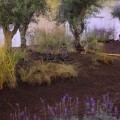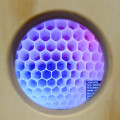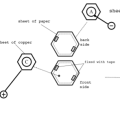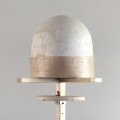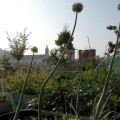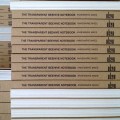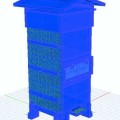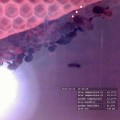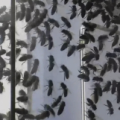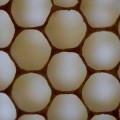SALINAS d'Addaia (floor sculpture, 2023)
Salt marshes are unique ecosystems at the transition of land and sea. They harbour plants and animals adapted to cope with salt stress. Intertidal salt marshes occur along the edges of shallow seas with soft sediment bottoms where the tidal range is considerable, zones that are flooded regularly by the tides. The obvious coloration of the salt marsh is caused by its microscopic algae,
MICROBIAL ANCESTORS pink (Topography of a Second Skin, textile work, 2023)
Microbial Ancestors (Topography of a Sensorial Skin) -the pink tapestry- is a woven interpretation of a Sensorial Skin. Its topographic view visualizes the ecology of the symbiotic organism composed of Acetobacter xylinum bacteria and Saccharomyces cerevisiae yeast cells and the several layers of cellulose woven by these bacteria to create the skin.
ACUARIO con Acetobacter xylinum (installation, 2023)
In a large aquarium, a fermentation process is taking place. The generative process is in a constant state of transition. The creation of the Sensorial Skin reacts to variable invisible factors as temperature, humidity and the local enzymes in the water and the air. Every newly grown Sensorial Skin is thus the unique result of the specific site were it is grown, with its own metabolism and aesthetic specificities.
MICROBIAL ANCESTORS orange (Topography of a Second Skin, textile work, 2023)
Microbial Ancestors (Topography of a Sensorial Skin) -the pink tapestry- is a woven interpretation of a Sensorial Skin. Its topographic view visualizes the ecology of the symbiotic organism composed of Acetobacter xylinum bacteria and Saccharomyces cerevisiae yeast cells and the several layers of cellulose woven by these bacteria to create the skin.
SENSORIAL SKINS (installations, variable)
Sensorial Skins are grown by bacteria during an acid fermentation process, the result of this action is called 'vegetable leather'. The Sensorial Skins undergo a visible metamorphosis due to the changing invisible factors as temperature and humidity specific to the location.
EXOSKELETON, topography of a second skin (the Winogradski experiment - 2023)
‘Exoskeleton, topography of a second skin’ are 2 lightboxes with photographs of the Winogradski experiment. The experiment researches what bacteria can tell us about the soil they live in. Soil samples (a highly diverse micro-ecosystem of soil bacteria and algae) were cultured for several weeks.
RITUALS with MICROBIAL ANCESTORS (performance, 2023)
Poetry is at the hart of alchemy. Flowers of speech.
Microbial Ancestors, fermentation.
Every death is a birth and every ending is a beginning. Transmutation.
It’s moist and slimy with an acid smell of lively matter.
TABLE WITH SENSORIAL SKINS (installation, 2023)
Since 2015, Anne Marie Maes has been developing organic material by fermenting bacteria and yeasts that leave behind a brownish vegetable leather once removed from their substrate. Expanding, curling, and hardening with the temperature or humidity in the air, these biofilms are called Sensorial Skins to emphasis their living and evolving nature.
PANTONE ALSACE / Reading the Landscape (installation, 2023)
The work 'Pantone Alsace (Reading the Landscape)' is emerging from a meticulously scanned environment. It takes the form of a Pantone colour chart to present a local chromatic range. After several walks to collect plants and fungi in the Alsace region, pigments were extracted to dye the wool which was then woven to obtain a work that bears witness to the "colourful" richness of the regional landscape, offering us a new way of looking at the world.
POEMS FROM A ROOFTOP GARDEN (tapestry works: pink/orange/green, 2023)
A woven topographic view visualizes the ecology of a symbiotic organism. It translates the collaboration between Acetobacter xylinum bacteria and Saccharomyces cerevisiae yeast cells. The original Sensorial Skins were grown in a culture of fresh hibiscus tea for the pink, and campèche-colored tea for the orange. The tapestries offer a play of light shining through the lightly woven,
the LARGE LOOM / Le GRAND METIER (sculpture/performance, 2023)
The Large Loom / Le Grand Métier is a custom-built, two-by-two-meter sculpture in brushed metal. It is a perfectly functional weaving loom that is set in motion by the artist at key points during the exhibition at La Kunsthalle, thereby creating a visual portrait of the region.
MICROBIAL LIFE (installation, 2023)
‘Microbial Life’ focuses on the transformative power of soil bacteria. The installation shows the result of a scientific experiment named ‘Winogradski Columns’. Soil samples (a highly diverse micro-ecosystem of soil bacteria and algae) were cultured for several weeks. The sealed cultures were developing independently over time,
PLEASE TOUCH (objects, 2022)
a Bee is a Bee is a Bee: a durational performance for the Palais the Tokyo, Paris. Commissioned by Vittoria Mataresse, in collaboration with Guerlain Paris and supported by CWB|Paris-hors-les-murs.
SMELL of the HIVE
The video Variation Games is a culmination of the observations carried out between 2017 and 2018 on the community behavior of bees. The images and sound, recorded with an infrared camera and a microphone installed inside the hive, reveal the democratic
a BEE is a BEE is a BEE (performance, 2022)
a Bee is a Bee is a Bee: a durational performance for the Palais the Tokyo, Paris. Commissioned by Vittoria Mataresse, in collaboration with Guerlain Paris and supported by CWB|Paris-hors-les-murs.
At Palais de Tokyo, Anne Marie Maes offers an immersive experience. With an artistic and scientific approach, she transforms the spaces of the Palais into a laboratory.
THE SEA GIVES AND THE SEA WILL TAKE (Theatrum Algaerium - performance video, 2021)
Early in the morning on the fifth day of the harvest month of August 2021.
The beach at Ostend. Bright blue sky. Footprints in a wet sandy beach.
LAMINARIA [webproject]
Laminaria is a website documenting and comparing marine ecosystems in Europe.
Laminaria operates on the border between sapiens and fauna. It outlines possible futures in a new bio/techno/natural world, a universe that is at once terrestrial and aquatic, a prerequisite for future coexistence.
THEATRUM ALGAERIUM (2021)
combining science, fiction and art
Early in the morning and late in the evening, between low and high tide, the Theatrum Algarium rises from the sea. Metal frames hold the fluttering weeds.
ALIEN INTELLIGENCE + BACTERIAL MANTAREY (2021)
'Bacterial Mantarey': this organic sculpture builds upon a body of research that focuses on biofilm formation.
DISAPPEARANCE (2021)
‘Disappearance’ focuses on change and temporality. Five plexiglass boxes are filled with lemons and tangerines that are slowly eaten away by bacteria, until nothing is left. In this degradation process, the organic matter progressively transforms and reduces, till the point of disappearance.
GUERRILLA BEEHIVE (2021)
The ‘Guerrilla Beehive’ is a sculpture & prototype resulting from a speculative research project. Conceived as a mobile shelter for swarming honeybees, it combines in a radical way smart materials, biomimetic forms and biotechnology.
L'ORIGINE DU MONDE II (2021)
Poetically representing extensive research into the potential of cyanobacteria and microalgae, L’origine du monde is composed of a metal structure on which glass cells, filled with cyanobacteria, are growing as they were young, sprouting buds on a tree in springtime.
TERRITORIAL FLOW (2021)
Over a dark metal structure, a soft flow of latex, natural pigments and beeswax mix to create a topographic map. The shapes are reminiscent of the bees’ foraging territory.
TABLE with SKINS (2021)
A selection of bacterial grown skins, microbial cellulose, in different sizes and thickness. Structures are variable. All colored with 100% naturel vegetal dyes, grown in the Brussels Urban Open Air Lab.
PLAY with SQUARES (2021)
Play with Squares is a floor sculpture composed of organically created textiles. They are arranged on a low wooden plinth, and their warm colours are derived from grasses, herbs, vegetables and fruits I grow in my rooftop garden/open-air laboratory. I use organic debris and natural additives to make these colourfield paintings, which evoke to a tranquil, almost meditative contemplation.
TERRITORY#1, assemblage bacterial grown materials
Assemblage made with organic materials. Microbial cellulose skins grown by Acetobacter xylinum and yeast cells, bioplastics with red algae, horse hair. Drawing. Dimensions variable ( 200cm x 120cm)
SHARED GARDENS: a proposition
A project developed for SHARED GARDENS, an exhibition at Magasins Généraux, from June 27 to September 13, in Paris at Pantin on the banks of Ourcq Canal. Focusing on the ecological and social transition, it is aimed at rethinking our ways of living together and our relationship with the environment, starting on a local scale.
SLOW METABOLISM and other objects
The electric green veins running through the bottle are colonies of cyanobacteria. They are slowly evolving and little by little they are colonizing the nutrient gel. They are autotrophe organisms, which means that they provide in their own food. They obtain their energy through oxygenic photosynthesis. They consume CO2 and they release oxygen, similar as plants do.
L'ORIGINE DU MONDE, installation
L’origine du monde is an artistic representation of my research into the possibilities of cyanobacteria and (micro) algae.
The installation shows a strongly enlarged bacterial chain made from glass cells. Every cell is filled with cyanobacteria producing realtime photosynthesis.
ALIEN INTELLIGENCE II, lightboxes
The work consists of a series of SEM (Scanning Electron Micrographs) printed on Duratrans and presented in lightboxes. The black/white micrographs are mixed with lightboxes in which I present colourful microbial cellulose skins (cellulose fabrics made by bacteria and colored by vegetal dyes).
the GOLDEN BEEHIVE, sculpture
We have to think about new materials, inspired by nature. We can experiment with a list of raw materials (list without limitation): corn starch, brown sugar, glutinous rice, coconut fibers, hemp, mushroom mycelium, silk, coffee ground, linen, cotton. We can e.g. cut old natural woven carpets with the lasercutter. We can dye raw materials with color extracts from plants as indigo (from the Indigofera tinctoria) or orange from the Calendula officials.
We can make hives out of flexible solar panels,...
Large scale SCANNING ELECTRON MICROGRAPHS
From the series of Scanning Electron Micrographs: intimate and compelling images on micro-organisms and their (urban) ecosystems, and how these organisms and environments are affected by the era of the anthropocene.
DISRUPTED SENSATIONS - small lightboxes
In my practice, the concept of making and producing the (light)sculptures and textiles is as a form of study. The artistic process happens in layers and is linked to the action of subtracting and adding. The concept of scale is very important. The volume of an object and its relationship with nature (micro/macro) are essential elements of my work. The choice of materials is a primary aspect of my artistic research. I always work with natural and organic components, and...
scale models IGB
A collection of small sculptures, developed during the research of the Intelligent Guerrilla Beehive project (2016-2019). The objects are presented in clear plexi boxes, each 13cm x 13cm x 13cm, on black or white sand. Each piece is unique. Materials: wax, latex, epoxy, bacteria, organic dyes, electronics, 3D printed PLA, seeds, aquarium sand.
![]()
UNTITLED (green and orange wall textile)
Untitled (green + orange wall textile). This piece is made out of fresh and salt water algae collected at the Venice Lagoon, at the Skibotn Fjörd in Norway and they are mixed with microalgae collected on a city rooftop. The orange textile is made from Tangerine skin peels. The work can be presented with or without backlight.
the INTELLIGENT GUERRILLA BEEHIVE 2.0 (algae power)
The project 'Intelligent Guerrilla Beehive 2.0' is researching the renewable energy that can be extracted from algae, to replace the solar panel as an energy source to power the sensors.
'What if' scenario: the environmental information of the foraging fields around the beehive is collected by the sensors in and around the hive, and its data is stored and processed in the cloud.
ELBBIENEN - Intelligent Guerrilla Beehive, Sculpture in Public Space
Honey bees use caves, rock cavities and hollow trees as natural nesting sites. The nest is composed of multiple honeycombs, parallel to each other, with a relatively uniform bee space. It usually has a single entrance. Western honey bees prefer ...
UNTITLED (Yellow - a tribute to Eva Hesse)
Untitled (Yellow, a tribute to Eva Hesse) is part of a series of works with bioplastics in different constallations: multiple layers, a range of organic pigments and testing combinations with different non-organic materials as well introduction and development of bacteria on the bioplastic matrix.
ALCHIMIA NOVA - video
The video, filmed in the studio and open air laboratory of AnneMarie Maes, gives an overview of the different elements of her research.
INTELLIGENT BEEHIVE 2.0 - sculpture with video
the Guerrilla Beehive 2.0 is a speculative project in which the sensors are powered by a cyanobacterial biofilm. The bacteria grow a dense biofilm on the outer shell of the sustainable beehive. The bees are scanning the health of the environment while foraging. When the bees return to...
GLOSSA and STIMULI - b/w micrographs lightboxes
From the series of Scanning Electron Micrographs: intimate and compelling images on micro-organisms and their (urban) ecosystems, and how these organisms and environments are affected by the era of the anthropocene.
TABLE with SKINS - sculpture
A selection of bacterial grown skins, microbial cellulose, in different sizes and thickness. Structures are variable. All colored with 100% naturel vegetal dyes, grown in the Brussels Urban Open Air Lab.
VISIBLE, INVISIBLE - textile works
In my practice, the concept of making and producing the (light)sculptures and textiles is as a form of study. The artistic process happens in layers and is linked to the action of subtracting and adding. The concept of scale is very important. The volume of an object and its relationship with nature (micro/macro) are essential elements of my work.
BACTERIAL MANTAREY - organic sculpture
This organic sculpture builds upon a body of research that focuses on biofilm formation; it is using the aggregation of bacterial colonies as a metaphore for the communication between a diversity of neighborhoods in cities. The biofilm as a city and the city as a biofilm.
A biofilm is an association of micro-organisms in which microbial cells adhere to each other on a living or non-living surface. Biofilm formation is a cooperative group behaviour. The bacteria communicate via quorum sensing
SIGNS OF LIFE - cohabitations
The scientific research of the project Sensorial Skin [for an Intelligent Beehive] focuses on turning the skin into a biosensor. I believe that working with cyanobacteria is a promising path to achieve the objectives regarding the responsive skin, because cyanobacteria are auto-trophe and they can live in colonies and react as such.
ECOLOGICAL FUTURES: Sensorial Sponge
I will investigate in how far a living bacterial sculpture can function as a CO2 reducing and oxygen generating object for use inside the home.
The development of this object will be based upon my previous work with cyanobacteria, I will implement the knowledge that I gathered during my biotech-project ‘Sensorial Skin’ (development of a pollution sensor).
THE INTELLIGENT GUERILLA BEEHIVE / part II
The Intelligent Guerilla Beehive is a bio-art installation on the edge of art and science. It evokes issues of sustainability and biodiversity, giving viewers an artistic experience of my ongoing research related to the disappearance of the honeybee.
Bees are bio-indicators. They reflect the health of their surrounding ecosystem as well...
GENESIS of a MICROBIAL SKIN
'Close reading of the Genesis of a Microbial Skin' gives a condensed overview of my notes (relating to the Intelligent Beehives research with a focus on SKIN) between 2012 to 2017. The project is about growing Intelligent Guerilla Beehives from scratch, with living materials - as nature does. Biomimesis is used as a starting point for incubating ecological thinking on matter and form. Different sensorial qualities of microbial and vegetal SKIN are being examined in terms of usefulness for sensing environmental threaths and for monitoring the wellbeing of the bee colonies.
VARIATION GAMES (video)
VARIATION GAMES are games where the set of rules is constantly adapted by the players.
The bees act as transmitters in an interconnected web of bio-intelligent agents. They construct a bioremedial beehive and create a symbiotic environment for exchange with specific bacteria.
THE LABORATORY FOR FORM AND MATTER
My experiments with smart materials have been brought together under the label 'the Laboratory for Form and Matter'. Here I study the processes by which nature operates and how I can use these processes to create my own intelligent materials. I experiment with a range of organic components and I measure their usability for art installations and design applications.
BEE AGENCY (scanning electron micrographs)
‘Agency’ is the capacity of an actor to act in a given environment. Since Darwin, it is clear that flowers and bees engage in an evolutionary race. The honeybee is a complex insect with numerous sensorial features which are matching perfectly with the demands of sensual plants.
INTELLIGENT GUERRILLA BEEHIVE & OTHER WORKS
AnneMarie Maes is a multi-media artist who has been studying the tight interactions and co-evolutions within urban ecosystems. In the open-air lab on the rooftop of her studio, she created an experimental garden and has been keeping bees in self-designed beehives, equipped to bring out hidden structures in the life of the colony. Her “field notes” provide an on-going source of inspiration for her artworks.
PH3 - FUTURE ARCHAEOLOGY
In my Laboratory for Form and Matter I work with a range of biotic and abiotic elements. I view my lab as an open environment for experimentation, a space for contradiction, criticism and evaluation. I combine organic components such as vegetal matter, propolis and chitine, with living systems such as fungi and bacteria to create artifacts for the future. My micro-organisms grow biofabrics and I research how these membranes can be enhanced and made...
ALIEN INTELLIGENCE
They are everywhere and they can be perceived as quite the alien intelligence; six-legged, with their numerous eyes, capacities of motion and sensation so different from our own. No wonder science fiction has been inspired by insects. But also other fields, like robotics as well as network design. Insects are more than creepy-crawly bugs;
SENSORIAL SKIN
Sensorial Skin is a series of macro photographs of microbial skins. The skins are grown by Acetobacter xylenum bacteria and yeast cells in a medium of green tea and sugar. The micro-organisms create a subtle biofilm on the growth medium. Once the film is harvested and dried, it feels like a second skin and it has the strength and impermedable properties of leather.
LIQUID BLOCKHEAD
The installation 'Liquid Blockhead' presents a collection of digitally fabricated objects as 3D-printed hexagons, 3D-printed ceramics of seedpods, and objects made from natural materials as felt, wax and rubber.There is a boxball-pendulum, a shelter turned into a plaster blockhead and stressballs made from little wax pellets.
COLLECTION, ACCROCHAGE
An accrochage of objects forthcoming from New Materialism. A synthesis of natural phenomena. A weird collection of objects. Experiments with digital and organic components, nature inspired algorithms (e.g. neural networks and deep learning), micro-organisms as a basis for computation and built-in efficiency of natural processes. The purpose is to make an artistic indicator of the biological condition of the foraging areas, via plant & pollen parts...
THE INTELLIGENT GUERILLA BEEHIVE / part I
The design of the Guerilla Beehive is inspired by nature. The content (± 40 liters) responds to the nest-needs of a bee colony living in the wild, and the mobile architecture makes it easily deployable on different spots in public space, hence its name: the Guerilla Beehive.
BLACK CIRCLE, WHITE CIRCLE, ORIGINAL SKIN
The Skins are experiments in developing new materials for making sculptures. They are a surface for encounter between the several vegetal and bacterial materials and site for experimentation. A place where material and patterns change into meaning, a tactile experiment that offers an entry to explore touch and feel, and that studies the specific qualities of each component.
THE AMBITION OF THE TERRITORY II
'The Ambition of the Territory' is a series of works that visually investigates the traces of memory and the communication in a honeybee colony.
The relatively simple nerve system of the honeybee is able to learn quickly. It forms multiple memory traces, including that of a long-term memory.
THE AMBITION OF THE TERRITORY
'The Ambition of the Territory' is a series of works that visually investigates the traces of memory and the communication in a honeybee colony.
The relatively simple nerve system of the honeybee is able to learn quickly. It forms multiple memory traces, including that of a long-term memory.
the TRANSPARENT BEEHIVE
The Transparent Beehive is a living sculpture in the form of an observation beehive made from plexiglass, wood, aluminium and steel. Inside is a living bee colony that has access to the outside world through a plexiglass pipe. The Transparent Beehive was installed for the first time on a Brussels rooftop connected to an urban garden laboratory and has since been shown...
TBH_3-CHANNEL VIDEO INSTALLATION
The Transparent Beehive is a living sculpture in the form of an observation beehive made from plexiglass, wood, aluminium and steel. Inside is a living bee colony that has access to the outside world through a plexiglass pipe. The Transparent Beehive was installed for the first time on a Brussels rooftop connected to an urban garden laboratory and has since been shown in various art contexts. It has helped to produce a variety of art works including sound works, visual images, and bee artifacts.
FLAGS, GRIDS, BANNERS and COLLAGES
A series of works made with cellulose skins.
There are cut-ups, geometrical works, experiments in combination with a range of organic materials, skins colored with vegetal dyes as avocado pits & peels, stinging nettles, eucalyptus bark, cochineal bugs or hibiscusflowers. Works in metal...
BEES AS ARCHITECTS
‘Bees as architects’ is the starting point for the work with wax and propolis. Bees can be seen as living 3D printers that reach an extreme grade of mathematical perfection when building a honeycomb. Through the centuries physics and mathematicians have wondered how a bee colony reaches this result. We want to take up the challenge to work just as constructive with 3D printers and organic materials such as chitosan, sugar, propolis or ...
INVISIBLE GARDEN - lightboxes
This work is inspired by The Battle of the Books, a work of Jonathan Swift. It especially draws meaning from the fable of the Spider and the Bee. Diverse knowledge is a precious good. No art pour l'art, but art embedded in life.
The Battle of the Books is the name of a short satire written by Jonathan Swift and published as part of the prolegomena to his A Tale of a Tub in 1704. It depicts a literal battle between books in the King's Library, as ideas and authors struggle...
MOEBIUS, sculpture
A Moebius-strip was printed in 3D (transparent resin) and put in a beehive. The colony, in full expansion, started to built waxcomb in the 3D structure. As such, a hi-tech 3D print is combined with a natural 3D print, a good example of biomimesis, advanced technology inspired on nature.
Similar experiment was executed with a paper truncated octahedron-shape. There, the bees started eating the paper and moved away the wax.
INFRARED OBSERVATION MOVIES
By displaying the installations and findings of the research at art/science exhibitions, the OKNO URBAN BEE LAB team gives a critical comment to spark the discussion on Urban Ecologies and the disappearance of the Honeybees, hereby emphasizing the importance of experimentation and continually evaluating what is possible in a close collaboration between scientists and artists, and between interdisciplinary fields...
INTELLIGENT BEEHIVE - SMARTSKIN DESIGN
The 3DPrint-project Bee Material, Bees as Architects serves to continue and deepen the research of the Brussels Urban Bee Lab. Bees can be seen as living 3D printers that reach an extreme grade of mathematical perfection when building a honeycomb. Through the centuries physics and mathematicians have wondered how a bee colony reaches this result. AnneMarie Maes and the Brussels Urban Bee Lab want to take up the challenge to work just as constructive with 3D printers and organic materials,...
SCAFFOLDED SOUND BEEHIVE
The Scaffolded Sound Beehive is an immersive installation in the form of a beehive. The viewer puts his or her head inside and experiences a visual and auditory artistic interpretation of hive activity.
The Scaffolded Sound Beehive is part of a series of ecological instrumented beehives leading towards a fully biocompatible intelligent beehive. T...
GUERILLA BEEHIVES STUDY
I want to populate cities with a network of Guerilla Beehives. These beehives should offer shelter to bee colonies 'in the wild' - rather than force bees into artificial apiaries. The bee colony should be able to thrive without the help of a beekeeper. Guerilla-beehives are intended for pollination and thus preservation and remediation of biodiversity.
Is it possible to produce Beehives that are as aesthetic and as...
L'ORTO INVISIBILE
L'orto Invisibile is dedicated to the documentation of the large-scale installation 'the Invisible Garden'.
During 3 months, an indoor ecosystem (the Invisible Garden in the Buda Factory) is observed in a naturalist way and the monitorings are scrutinously documented in several databases. I am particularly interested in how the life style of an organism (be it a plant or an animal born in the indoor garden) fits in with the other organisms...
SOUND BEES anywhere & everywhere - 8 channel soundpiece
Soundbees, anywhere & everywhere is an audio piece by AnneMarie Maes and Billy Bultheel.
AnneMarie Maes and Billy Bultheel started to develop the audio piece from the 8-channel field recordings made in the broodnest of the experimental Warré-beehive set-up (see drawing).
The sound-behaviour of the bee colony was recorded from june 10 2014 and the sound-experiment is still ongoing. For the Kunstradio piece, the artists started to work with the recordings from the longest ...
SEM PHOTOGRAPHS [lightboxes]
The work is a series of 8 lightboxes, representing microscopical photographs of bee-parts and pollen grains. The photos are made with the high-end Scanning Electron Microscope (SEM), which is used for scientific research and can display greatly enlarged images of objects, also in 3D view. The study (in collaboration with scientists from the VUB) lead to a remarkable series of microscopical photographs. Honeybee parts (proboscis, antennae, legs,...
INVISIBLE GARDEN
The Invisible Garden / l'Orto Invisibile. Naturalistic Observations and Hidden Memories. is a large-scale art installation in the exhibition the Green Light District : the place of Nature in...
CONNECTED OPENGREENS PUBLICATION part #1, 2, 3, 4
A 4 volumes publication, covering the actions from 2009 to 2010 in the Open Air Lab 'Connected OpenGreens'.
The Open Green project blends organic and technological matter into one and the same nature. Through analogue and digital means we do long term observations on the growth, blossoming and decay of plants and insects submitted to natural elements such as wind, sun, rain and pollution in an urban context.
the PEEPHOLE (dancing bees), installation
Bee Monitoring. The raw material is an 8 TerraBytes stream of images. During 10 months I studied a colony's development from scratch: from a late-spring swarm till the new spring one year later. Two (2) webcams filmed continuously in the beehive, at 15/fps, day and night. The videofiles were accelerated and compressed into 1 file of 11hours 35 minutes.
For the FIELDS exhibition in Riga, this long videofile was presented in a box with a peephole, in respect to the private ...
HONEY BATTERIES, workshop/performance
Why honey batteries and how to make them? I did some experiments with honey batteries: the honey as electrolyte gel, the copper- and aluminum foil work as electrodes, thin coffee filter paper as isolator. It works fine and the generated current lights up some connected LEDS for a while.
Since honey contains electrolytes, in the form of acids and minerals, it exhibits varying degrees of electrical conductivity. Experimenting with honey batteries is a nice way to learn about possibilities of powering the sensors in the ...
GUERILLA BEEHIVES, sculptures
I want to populate cities with a network of intelligent ‘guerilla-beehives’. These beehives should offer shelter to bee colonies 'in the wild' - rather than force bees into artificial apiaries. The bee colony should be able to thrive without the help of a beekeeper. Guerilla-beehives are intended for pollination and thus preservation and remediation of biodiversity.
I imagine a world where biological fabrication replaces traditional manufacturing and thus where new sustainable bee...
FLIGHTROUTES part#2 (urban farm), installation
As media-artist and beekeeper I am studying since 2009 the co-evolution between city honeybees and urban ecosystems. In many industrialised nations the bee colonies are threatened, often because of the state of ecology in the bees’ foraging areas. It is remarkable to see how a bee population functions and evolves very much in accordance to the human activities we are developing around them: gardening an...
FLIGHTROUTES part#1 - installation
Bees are a means for exploring how humans interact with and understand nature. As an urban ecologist, I study the link of the honeybees to the environment. The bees' overlapping foraging areas create ecological corridors throughout the city. By hacking rooftops and transforming them into urban gardens, I am experimenting with new forms of sculpting the public space. It generates a form of site-specific art intended to provoke change. Ecological corridors in urban environments ...
CONNECTED OPENGREENS - online database project
Can the gardens’ evolution be controlled, generated, enhanced or imagined in artworks? Does the fusion of natural and artificial matter produce new organisms, new environments, new forms of nature? Can technology animate nature and vice versa?
The Open Green is an artificial environment, a hybrid of nature and culture. The harvest is about scraping data of any kind from the garden and using it for organic ánd media applications.
We store the data of...
TRANSPARENT BEEHIVE NOTEBOOK - publication
The Transparent Beehive Notebook gives an overview of the Transparent Beehive Project. It describes in words and images the intense process of Bee Monitoring and the close collaboration with numerous colleague artists, scientists, engineers and beekeepers. The relation bees and flowers is an evident one and is never far away in this notebook. In an artistic way and starting from hands on experiences as a beekeeper, I give an account of the building of monitoring systems and their implementation in the beehives at the open field labs. Working with...
POLLEN SERIES - black/white SEM photo series
This work is a series of photographs made with the high-end SEM microscope. During 2 months I was invited to work at the chemical engineering laboratory of the Vrije Universiteit Brussels (VUB) to carry out research on city honeybees and their relation to the urban environment. As well the honeybees, as the pollen grains the bees were bringing back from their foraging flights, were closely inspected under the SEM microscope.
TOTEM BEEHIVE - architecture, design
To monitor the bees in a non-intrusive way we are building Intelligent Beehives. These are hives that are augmented with sensors and sensory processing algorithms that analyse the quality of pollen and propolis as well as the behavior of the bees in order to monitor the state of the ecology in the surrounding areas. In a first research phase, the people's hive of Abbé Warré was adapted to the grid of the Open Structures project. The new Warré-hives are a collaboration between OKNO Br...
BEES, WEBCAM 365 DAYS - timelapse video installation 11:35:00
The Bee Monitoring project probes deeply within a network of ICT-enhanced beehives. Between may 2011 and april 2012, a complete cycle, from the awakening till the hibernation of the bee population, was recorded in a continuous stream of pictures, sound and sensor data. All this information is readily available online for beekeepers, scientists and other artists, offering an opportunity to study the bees as bio-indicators.
Two...
BEES, WEBCAM 24hours and BEES, TRAIL - timelapse video installation
The videos bees-webcam 24hours and bees-trail are generally presented in a 3 channel video installation together with the bees-webcam 365days video. All 3 videos give an artistic survey of working with an observation beehive. The beehive is enhanced with different sensors and with 2 webcams inside.
The video bee-trail renders the timelapse in the beehive by showing the trail of honeybees...
BEES, MONITORING - 3 channel video installation
3 channel video installation representing the monitoring of the Transparent Beehive from beginning of may 2012 to the end of april 2013. The Transparent Beehive was set up in the Drying Room, the laboratory connecting to the okno rooftop garden in the center of Brussels. The fragments in the videos were filmed over the time of the season on regular intervals. Click the images to play the 3 videos together.
ON A DIFFERENT SOIL - installation
Presentation of the Connected OpenGreens database in installation setup. A miniature garden in a rusty metal table becomes alive with a close reading by a microscope. The image is magnified and projected on the wall, people can sit and meditate whilst being absorbed by the life projection.
The work was presented on the international conference 'Growth in art, society and culture', organized within the framework of the project TIK (Time Inventors’ Kabinet) and as an accompanying p...
TRAVELING THOUGH OPEN GREENS - publication
A pertinent question in ecological research is: Can artists make translations between biology, entomology and technology?
Don’t expect a balanced answer to this issue. This topic is a source for a long debate, one that has to be conducted collaboratively among the larger group of Time Inventors. Our shared work can become a common investigation into time relations within biological and circumstantial ecologies, through the lens of aesthetics.
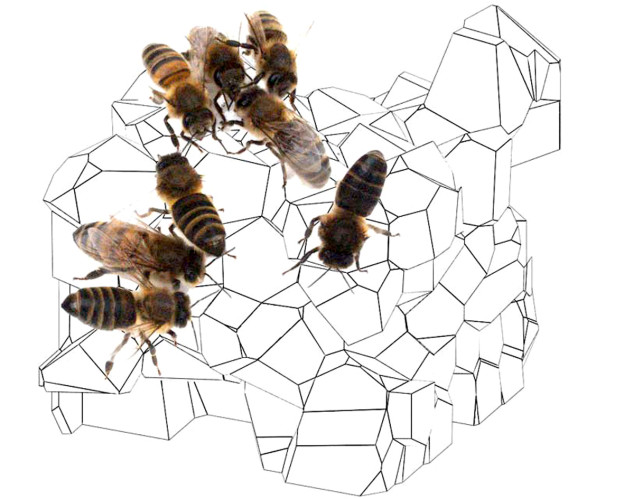
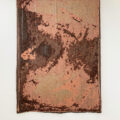
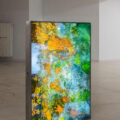
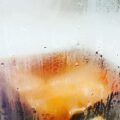
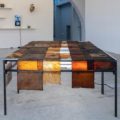

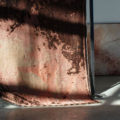



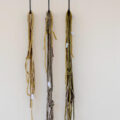
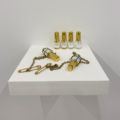
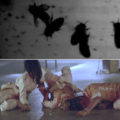
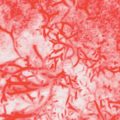
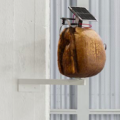




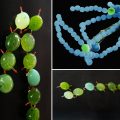

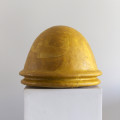
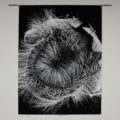




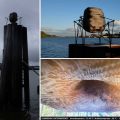
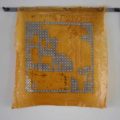

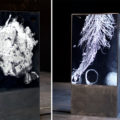
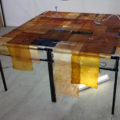
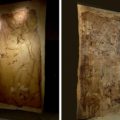
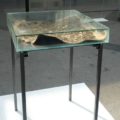
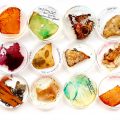
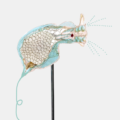

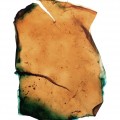




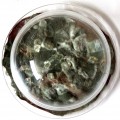

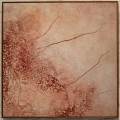


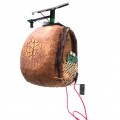

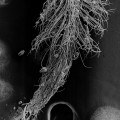
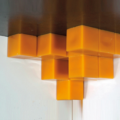
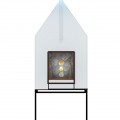


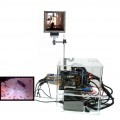


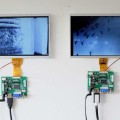
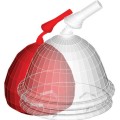
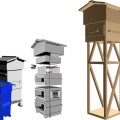



![SEM PHOTOGRAPHS [lightboxes]](https://annemariemaes.net/wp-content/uploads/2014/09/DSCF2683-120x120.jpg)
